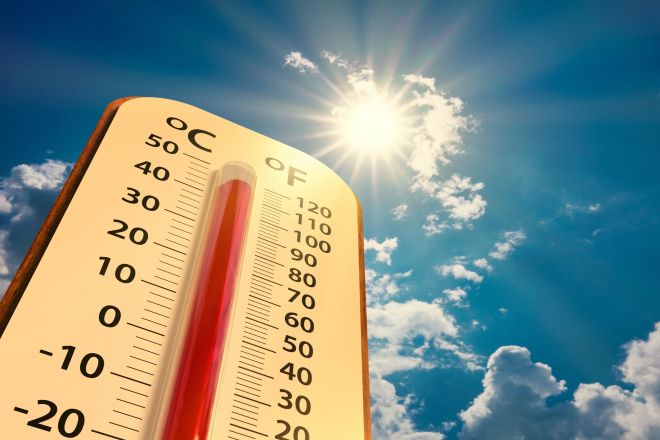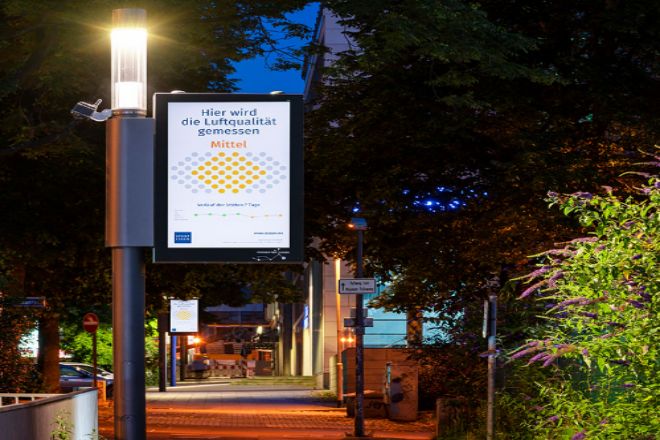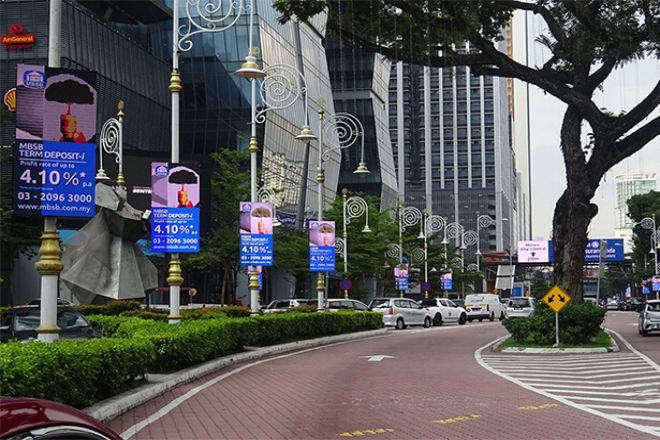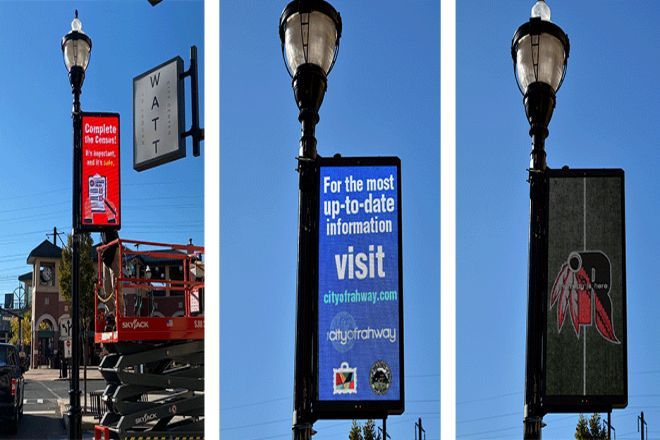序章

暑い夏には高温の気候が常態化し、屋外の電子機器、特にポール LED ディスプレイ スクリーンにとって厳しい試練となります。
現代都市の情報構築の重要な部分として、 ポールLEDディスプレイ スクリーンは交通案内、情報公開、 広告高輝度、広視野角、簡単設置などの利点を活かし、様々な分野で活躍しています。
しかし、高温は LED ディスプレイ画面の発光効率と寿命に影響を与えるだけでなく、安定性と信頼性を脅かし、正常な動作と耐用年数にも影響を与えます。
したがって、ポール LED ディスプレイ スクリーンが高温の気候に効果的に対応し、高温環境での安定した動作を確保する方法を研究することは、大きな実用的意義と実際の応用価値があります。
1. ポールLEDディスプレイスクリーンの紹介

ポール型 LED ディスプレイ スクリーンは、ランプ ポール型 LED ディスプレイ スクリーンとも呼ばれ、屋外広告や公共情報の公開において重要な役割を果たします。
これらのディスプレイスクリーンは、街灯柱やその他の公共施設に巧みに設置されており、都市空間を最大限に活用するだけでなく、ユニークな方法で都市の視覚的な景観を豊かにします。
1). 主要な役割の簡単な説明:
- 情報発信の架け橋:
街灯柱の LED ディスプレイ スクリーンは、情報発信者と一般の人々をつなぐ重要な架け橋です。
商業広告、公共福祉の宣伝、緊急のお知らせなど、これらのディスプレイは、通行する歩行者や車両に情報を迅速に伝え、広範囲に情報を伝達し、タイムリーな情報伝達を実現します。
- 視覚的な魅力を高める:
街灯柱のLEDディスプレイは通常、交通量の多い場所に設置されており、高い視認性という特徴を持っているため、 輝度 鮮やかな色彩で人々の注目を集めることができます。
この強い視覚的インパクトにより、広告コンテンツはより記憶に残りやすくなり、宣伝効果が向上します。
- 環境への柔軟な適応:
街灯柱LEDディスプレイのデザインは柔軟性と多様性に富み、様々な環境やニーズに合わせてカスタマイズできます。狭い通りでも広い広場でも、最適な設置場所を見つけて効果的な情報発信を実現できます。
2. ポールに取り付けられた LED ディスプレイは高温によってどのような影響を受けますか?
街灯柱に設置されたまばゆいばかりの大型スクリーンであるポール設置型LEDディスプレイへの高温の影響は、実は夏の暑さに感じる不快感に似ています。スクリーンも「高温試験」を受け、まるで「熱中症」のような状況に陥るのです。
1). 高温下で発生する可能性のある即時の問題
- 画面の「発汗」:
強い直射日光の下では、ポール LED ディスプレイ内の電子部品は炉の中にいるかのようになり、暑い夏に人体が汗をかくのと同じように、熱を蓄積し始めます。
この熱の蓄積により、画面の表面温度が急激に上昇するだけでなく、内部の回路基板や電子部品の過熱も引き起こす可能性があります。
過熱はこれらのコンポーネントの正常な動作に影響を与えるだけでなく、ショートやオープン回路などの一連の障害を引き起こす可能性があり、ディスプレイ全体のパフォーマンスと安定性に影響を与えます。
- 暗い明るさ:
高温環境は、LEDランプビーズに目に見えないヨークをかけたようなもので、発光能力を制限します。LEDチップの発光効率は温度と密接に関係しており、温度が上昇すると発光効率は著しく低下します。
つまり、高温になるとポール LED ディスプレイの明るさが大幅に低下し、本来鮮明なテキストや画像がぼやけて、視聴の快適さや情報の伝達効果が大幅に低下します。
- 色の歪み、視覚的な饗宴の変化:
高温はLEDディスプレイの色彩性能に悪影響を与える可能性があります。LEDチップの波長は温度変化によって変化するため、本来表示される色が不正確になります。
たとえば、明るい赤は鈍いオレンジ色になり、透明な青は濁った紫色になることがあります。
この色の歪みは、画像の美しさを損なうだけでなく、視聴者の情報理解を誤らせ、情報の正確な伝達に影響を及ぼす可能性があります。
2)長期的な影響
- 物質的な老化、若さはもう存在しない:
ポールLEDディスプレイ内部の材料(LEDパッケージング材料、回路基板、電子部品など)は、長期間の高温環境下では徐々に本来の性能と安定性を失います。
徐々に弾力性を失い、太陽光にさらされた皮膚のように脆く脆弱になります。この素材の老化は不可逆的であり、ディスプレイの耐用年数と安定性を著しく低下させます。
- 寿命が大幅に短くなり、頻繁な交換が当たり前になります。
高温は容赦ない加速装置のようなもので、ポールLEDディスプレイの劣化を加速させ、本来長寿命設計のディスプレイであっても、短期間で性能低下や故障の多発を引き起こします。
これにより、ユーザーの保守および使用コストが増加するだけでなく、頻繁な交換や修理により情報の継続的な公開と配信にも影響が出る可能性があります。
3. 高温時のポールLEDディスプレイスクリーンの注意事項

高温期におけるポール型LEDディスプレイスクリーンの予防保守は、安定した動作を確保し、耐用年数を延ばすために不可欠です。具体的な予防保守の推奨事項を以下に示します。
1). ディスプレイ画面の冷却システムを定期的に点検する
- 冷却システムの検査:
冷却システムは、高温環境下でポール LED ディスプレイ スクリーンを正常に動作させるための鍵となります。
冷却ファン、ヒートシンク、その他のコンポーネントが正常に動作しているかどうかを定期的に確認し、詰まりやほこりの蓄積がないことを確認してください。
圧縮空気または専門の掃除機を使用して冷却システムを清掃し、良好な放熱性能を維持することができます。
- 温度監視:
温度センサーを使用して、ディスプレイ画面内の温度をリアルタイムで監視します。
温度が高すぎることが判明した場合は、冷却装置を追加したり、ディスプレイ画面の動作モードを調整したりするなど、温度を下げるための措置をすぐに講じる必要があります。
2). ディスプレイ画面が適切な場所に設置されていることを確認する
- 直射日光を避けてください:
ポール型LEDディスプレイを設置する際は、直射日光を避け、太陽放射によるディスプレイスクリーンの直接加熱を軽減する場所を選択してください。直射日光を避けられない場合は、他の方法で遮光してください。
- 換気条件を考慮してください。
設置場所を選択するときは、ディスプレイ画面から発生する熱が時間内に放散されるように、周囲の換気状態が良好であることも確認してください。
3)直射日光を避けるため、サンバイザーや日よけネットを使用する
- サンバイザーを取り付けます。
ディスプレイ画面の上にサンバイザーを取り付けると、直射日光を効果的に遮断し、ディスプレイ画面表面の温度を下げることができます。
サンバイザーは長期安定性を確保するために、耐高温性と耐腐食性を備えた材料で作られている必要があります。
- 日よけネットを使用する:
サンバイザーに加えて、サンシェードネットなどの日よけ設備も利用できます。サンシェードネットは日よけ効果だけでなく、一定の通気性も備えているため、熱を逃がすのに役立ちます。
4. 高温時のポールLEDディスプレイスクリーンのメンテナンスと手入れ
ポール型LEDディスプレイスクリーンを高温下でメンテナンスするには、極端な温度環境下でも安定した動作を維持し、耐用年数を延ばすために、一連の特別な対策を講じる必要があります。主なメンテナンス手順と戦略を以下に示します。
1). 放熱管理の強化
- 放熱システムを確認します。
まず、ディスプレイ画面の放熱ファンやヒートシンクなどの放熱部品が正常に動作しているかどうかを定期的に確認し、詰まりやほこりの蓄積がないことを確認します。
圧縮空気や掃除機を使用して清掃し、放熱効率を向上させることができます。
- インストール場所を最適化します。
可能であれば、ディスプレイ画面は風通しが良く、直射日光を避けた場所に設置してください。設置場所が固定されている場合は、オーニングや遮光ネットなどの遮光設備を設置し、直射日光による熱を軽減することを検討してください。
- 冷却補助装置を追加します。
非常に暑い天候の場合は、冷却効果を高めるために、産業グレードの冷却ファン、ヒートパイプラジエーターなどの追加の冷却装置をディスプレイに追加することを検討できます。
2). 電気系統を定期的に点検する
- 電源と信号線を確認します。
電源線と信号線がしっかりと接続され、経年劣化や損傷がないことを確認してください。高温による電気系統の故障を防ぐため、電気絶縁性能を確認してください。
- 電源安定性:
高温になると電源が不安定になる可能性があるため、ディスプレイが安定した電源環境で動作するように、電源電圧と電流の安定性を定期的にチェックする必要があります。
3)監視と調整
- 温度監視:
温度センサーを設置して、ディスプレイ内部の温度をリアルタイムで監視してください。温度が安全基準を超えた場合は、直ちに冷却措置を講じてください。
- 明るさと稼働時間の調整:
暑い天候では、ディスプレイの明るさを適切に下げ、稼働時間を短縮して、熱の発生と蓄積を減らします。
同時に、インテリジェント制御システムにより、周囲温度に応じてディスプレイの動作状態を自動的に調整できます。
4). 老朽化した部品を交換する
- シールおよび放熱材:
ディスプレイの密閉性と放熱性を確保するために、定期的に老朽化したシールと放熱材を点検し、交換してください。
- 電子部品:
LED ランプビーズ、ドライバ チップなど、高温により劣化した電子部品は、障害の拡大を防ぐために適時に交換する必要があります。
5. 緊急対応戦略

1). ディスプレイを素早く冷やす
- 扇風機を使って吹き飛ばす:
太陽の下でとても暑いと感じたと想像してみてください。誰かに扇いでもらったら、涼しく感じますか?同じように、ディスプレイに大きな扇風機を設置して風を送ると、ディスプレイの熱が奪われ、すぐに冷めるようになります。
- 日よけを作る:
ディスプレイが屋外にある場合、長時間太陽の下に立っていると熱中症になるのと同じように、ディスプレイも非常に熱くなります。
このとき、ディスプレイ用のパラソルのように、素早く日よけを作ったり、日よけネットを吊るして直射日光を遮ったりして、涼しくすることができます。
2). ディスプレイの作業負荷を軽減する
- 明るさとコントラストを下げます。
夜に読書をするときに照明を暗くするのと同じように、ディスプレイの明るさとコントラストを下げることができます。これにより、ディスプレイの負担が軽減され、発熱も抑えられます。
- 省エネモードに切り替える:
一部のディスプレイには、携帯電話の省電力モードのように、省電力モードが搭載されています。この機能をオンにすると、ディスプレイはより「省電力」になり、不要なエネルギー消費が削減され、当然ながら発熱も抑えられます。
- 労働時間を短縮する:
ディスプレイを常時オンにする必要がない場合は、稼働時間を短縮することを検討してください。例えば、以前は一日中オンにしていたディスプレイを、必要な時だけ短時間オンにするなどです。これにより、ディスプレイへの負担を軽減し、過熱を防ぐこともできます。
3). ディスプレイの状態に注意してください
- 温度計を設置します。
ディスプレイの横に温度計を設置するか、より高度な方法として、ディスプレイ内部に温度センサーを直接設置することもできます。これにより、ディスプレイの温度を常に把握でき、温度が高すぎる場合はすぐに検知して対策を講じることができます。
- 警告ラインを設定します:
70℃などの温度警告ラインを事前に設定できます。ディスプレイの温度がこの警告ラインに達するか超えると、すぐに冷却するか動作モードを調整するかの対応が必要になります。
4)緊急事態に対処するための計画を準備する
- 緊急チームを設立する:
技術者やメンテナンス担当者を含む緊急対応チームを事前に編成しておくことで、ディスプレイに問題が発生した場合、迅速に現場に駆けつけ、問題を解決できます。
- 予備機器を準備する:
家庭で予備の電球を用意するのと同じように、予備のディスプレイも用意しておくと便利です。こうすることで、メインのディスプレイに深刻な問題が発生して使用できなくなった場合でも、すぐに予備のディスプレイに交換して、正常に使用できる状態を保つことができます。
結論
要約すると、暑い気候でのポール LED ディスプレイの安定した動作は、科学的な放熱設計、完璧な環境制御システム、高品質の材料の選択、厳格なテストと品質管理と切り離せません。
科学技術の進歩と産業の発展に伴い、将来のポールLEDディスプレイはさまざまな複雑な環境にさらに適応し、スマートシティの構築と人々の生活にさらなる利便性と驚きをもたらすと確信しています。
最後に、LEDディスプレイについてもっと知りたい方は、 ご連絡ください。
